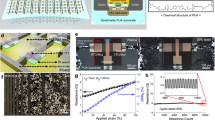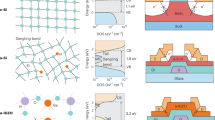Inexpensive sophisticated circuitry can be ‘painted’ on to plastic or glass substrates.
Abstract
Macroelectronic circuits made on substrates of glass or plastic could one day make computing devices ubiquitous owing to their light weight, flexibility and low cost1. But these substrates deform at high temperatures so, until now, only semiconductors such as organics and amorphous silicon2 could be used, leading to poor performance. Here we present the use of low-temperature processes to integrate high-performance multi-nanowire transistors into logical inverters and fast ring oscillators on glass substrates. As well as potentially enabling powerful electronics to permeate all aspects of modern life, this advance could find application in devices such as low-cost radio-frequency tags and fully integrated high-refresh-rate displays.
Similar content being viewed by others
Main
The mobility of single-crystal semiconducting nanowires is comparable to that of computer-grade silicon3. Multi-nanowire transistors4,5 — analogous to thin-film transistors — can be assembled from solution on pieces of glass and plastic6. For many applications, however, fully interconnected nanowire devices that function as viable circuit elements operating at high frequencies will be required.
We integrated two nanowire thin-film transistors to generate inverters (Fig. 1a), which we made in a parallel process over glass substrates by using standard photolithography techniques (for methods, see supplementary information). The process gives a high yield of devices that show reliable, well defined signal inversion under direct current conditions (see supplementary information). Investigation of the alternating-current response of these inverters (Fig. 1b) shows that the gain, or signal amplification, is greater than unity, and the expected phase inversion is achieved when these devices are driven by a 1-MHz sine wave at a supply of 15 V. As signal propagation in an integrated system requires gain that is greater than unity, these results and the high reproducibility of our nanowire transistors suggest that fully interconnected nanowire oscillators could operate in the megahertz regime.
a, Circuit diagram and schematics of the multi-nanowire inverters. Labelled voltages are bias (Vsupply), input (Vin) and output (Vout) voltage. The dielectric is omitted in the perspective schematic for clarity. ‘Via’ indicates one of a pattern of holes in the dielectric layer that are used to connect different metal layers. b, Output waveform (green) of an inverter fabricated on glass driven by a 1-MHz sine wave (red) with Vsupply=15 V. c, Optical images and circuit diagram of nanowire ring oscillators. The gate level edge, source-drain level edge and nanowires appear green, pink and white, respectively, in dark field. Scale bar, 100 µm. d, Oscillation of 11.7 MHz in a ring oscillator structure with Vsupply=43 V.
Our ring oscillators consist of three inverters in series (Fig. 1c), where the input of each inverter is connected to the output of the previous device, with a feedback loop to complete the ring. The necessary on-chip integration is achieved during fabrication and does not require any external wiring. We characterized the nanowire ring oscillators on glass substrates and found that the output-voltage oscillations were stable and self-sustained.
The devices show a maximal oscillation frequency of 11.7 MHz, corresponding to a stage delay of 14 ns (Fig. 1d). Significantly, all devices measured on glass have oscillation frequencies at or above 10 MHz. Furthermore, nanowire oscillators made on glass substrates have higher frequencies than devices made on silicon substrates (see supplementary information). This could be a key advantage for nanowire circuits as the properties of devices made with other materials often degrade upon transfer to non-crystalline substrates7.
The stable oscillation frequencies seen for our nanowire-based devices are many orders of magnitude larger than previous ring oscillators based on nanoscale building blocks. For example, carbon-nanotube devices have oscillation frequencies from 5 to 220 Hz (refs 8, 9). Although this is not an intrinsic limit for nanotubes, it highlights how important reproducible material properties are for the successful creation of integrated, high-performance devices.
It is interesting to compare these nanowire-device features with those of organic ring oscillators, given that the active material in both can be deposited at ambient temperatures from liquid solutions. Reported stage-delay times for organic ring oscillators are typically longer than 300 ns (ref. 10) and therefore substantially (20×) slower than those we obtain for nanowires on glass. Comparable results have been seen for other semiconductors with low synthesis temperatures; to our knowledge, the fastest reported stage delay for amorphous silicon ring oscillators is 210 ns (ref. 11).
Our integrated nanowire-based transistors open the way to a variety of electronic applications; the techniques we describe are all compatible with low-deformation-temperature materials such as plastics, broadening the scope for design. One limitation is that supply voltages of 35 volts or more are required to achieve stable oscillations, but device structures could be improved by incorporating higher-k dielectrics, more advanced nanowire materials and reduced channel lengths. This would enable them to be operated at lower voltages and much higher frequencies, taking low-cost electronics to high-performance computing levels.
References
Gelinck, G. H. et al. Nature Mater. 3, 106–110 (2004).
Street, R. A. Technology and Applications of Amorphous Silicon (Springer, New York, 2000).
Cui, Y., Zhong, Z., Wang, D., Wang, W. U. & Lieber, C. M. Nano Lett. 3, 149–152 (2003).
Jin, S. et al. Nano Lett. 4, 915–919 (2004).
Duan, X. et al. Nature 425, 274–278 (2003).
McAlpine, M. C. et al. Nano Lett. 3, 1531–1535 (2003).
Shimoda, T., Inoue, S. & Utsunomiya, S. Proc. SPIE 4295, 52–59 (2001).
Bachtold, A., Hadley, P., Nakanishi, T. & Dekker, C. Science 294, 1317–1320 (2001).
Javey, A., Wang, Q., Ural, A., Li, Y. & Dai, H. Nano Lett. 2, 929–932 (2002).
Clemens, W., Fix, W., Ficker, J., Knobloch, A. & Ullmann, A. J. Mater. Res. 19, 1963–1973 (2004).
Hiranaka, K., Yamaguchi, T. & Yanagisawa, S. IEEE Electron Device Lett. 7, 224–225 (1984).
Author information
Authors and Affiliations
Corresponding author
Ethics declarations
Competing interests
The authors declare no competing financial interests.
Supplementary information
Supplementary Methods
Summary of methods used for device fabrication and electrical characterization. (PDF 75 kb)
Supplementary Figure S1
Direct current characterization of high performance multiple-nanowire inverters. (PDF 49 kb)
Supplementary Figure S2
Alternating current characterization of high performance multiple-nanowire circuits fabricated on oxidized Si substrates. (PDF 202 kb)
Rights and permissions
About this article
Cite this article
Friedman, R., McAlpine, M., Ricketts, D. et al. High-speed integrated nanowire circuits. Nature 434, 1085 (2005). https://doi.org/10.1038/4341085a
Published:
Issue Date:
DOI: https://doi.org/10.1038/4341085a
This article is cited by
-
A conductive polymer nanowire including functional quantum dots generated via pulsed laser irradiation for high-sensitivity sensor applications
Scientific Reports (2021)
-
The fabrication and application of Ni-DNA nanowire-based nanoelectronic devices
Nano Research (2019)
-
Exploration and characterization of the memcapacitor and memristor properties of Ni–DNA nanowire devices
NPG Asia Materials (2017)
-
Investigation on thermal and cryogenic behaviour of carbon nanotube spun yarns using a dynamic mechanical analyser
Journal of Materials Science (2016)
-
Nanoscience and the nano-bioelectronics frontier
Nano Research (2015)
Comments
By submitting a comment you agree to abide by our Terms and Community Guidelines. If you find something abusive or that does not comply with our terms or guidelines please flag it as inappropriate.




